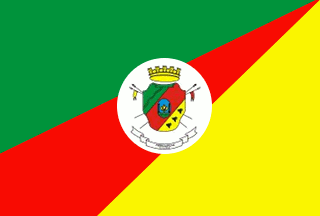 image by Dirk Schönberger,
12
February 2012
image by Dirk Schönberger,
12
February 2012Source: http://www.farroupilha.rs.gov.br/index.php?option=com_content&task=view&id=11&Itemid=13

Last modified: 2020-07-25 by ian macdonald
Keywords: rio grande do sul | farroupilha |
Links: FOTW homepage |
search |
disclaimer and copyright |
write us |
mirrors
 image by Dirk Schönberger,
12
February 2012
image by Dirk Schönberger,
12
February 2012
Source:
http://www.farroupilha.rs.gov.br/index.php?option=com_content&task=view&id=11&Itemid=13
The municipality of Farroupilha (63,641 inhabitants in 2010; 362 sq. km) is located in northeastern Rio Grande do Sul, 110 km of Porto Alegre. Farroupilha is the National Capital of Textile and the 1st producer of kiwis and Muscat grapes in Brazil. Farroupilha is the cradle of Italian immigration in Rio Grande do Sul. The first colonists, led by Stefano Crippa, Tomazo Radaelli and Luigi Sperafico, from Milan, settled in 1875 the place subsequently named Nova Milano (New Milan), today a district of Farroupilha. The colony of Linha Vicenze, subsequently renamed Nova Vicenza, was settled by Italian immigrants coming from the Conde d'Eu colony, attracted by the promising development of the new colony. A new Nova Vicenza emerged after the building of a railway station on the Montenegro-Caxias do Sul line, established the 2nd district of Caxias do Sul in 1927. The municipality of Farroupilha was established by State Decree No. 5,779 of 11 December 1934. The name of the municipality recalls the Farroupilha Revolution, whose centenary was celebrated the next year.
Ivan Sache, 20 March 2012
A radiating diagonal tricolour emerging from the upper hoist, green over red over yellow, with the municipal arms in the centre in a white disk.
Official website is at
http://www.farroupilha.rs.gov.br.
Dirk Schönberger,
12 February 2012
The flag of Farroupilha has four colors representing faith (green), strong-mindedness (red), commitment to work (yellow) and mind purity (white).
The coat of arms of Farroupilha, designed by Valter Spaldi, is
prescribed by Municipal Law No. 655 of 20 December 1963.
The Italian shield recalls the origin of the inhabitants; the green,
yellow and red colors are those of the flag of Rio Grande do Sul.
The green stripe charged with a bend sinister wavy recalls that
Farroupilha is located on the highest part of the Planalto and rich in
water, such as those supplied by Arroio Pinhal and Salto Ventoso.
The red stripe is charged with the Farroupilha Revolution shield, also found on
the coat of arms of Rio Grande do Sul.
The yellow stripe is charged with three bunches of grapes symbolizing
agriculture and industry.
Below the shield, a green scroll (shown in white on the drawing) is
charged with the name of the municipality and its date of emancipation.
http://www.farroupilha.rs.gov.br/index.php?option=com_content&task=view&id=11&Itemid=13
Ivan Sache, 20 March 2012
The coat of arms of Farroupilha is prescribed by Municipal Law No. 655
promulgated on 20 December 1963.
Article 1.
An Italian shield divided
per bend sinister, on a field gules the central part of the Ragamuffin coat of
arms (from 1835, kept in the Júlio de Castilhos Museum); in chief, on a field
vert a fess wavy argent; in base, on a field or, three bunches of grapes purpure;
beneath the shield a scroll vert inscribed with the date of political
emancipation and the name of the town, in letters argent. The shield surmounted
by five-towered mural crown argent.
https://leismunicipais.com.br/a/rs/f/farroupilha/lei-ordinaria/1963/66/655/lei-ordinaria-n-655-1963-e-adotado-o-brasao-para-o-municipio-de-farroupilha
Leis Municipais database
Ivan Sache, 18 July 2020